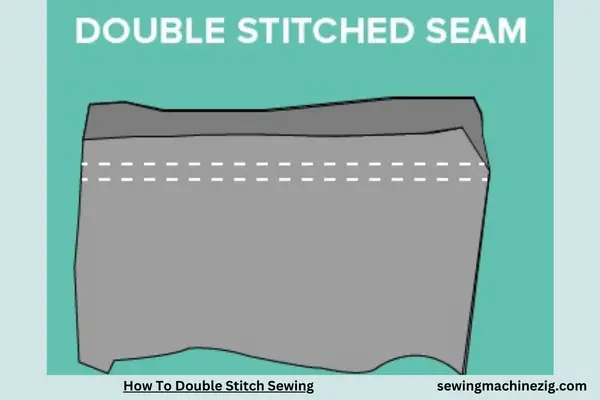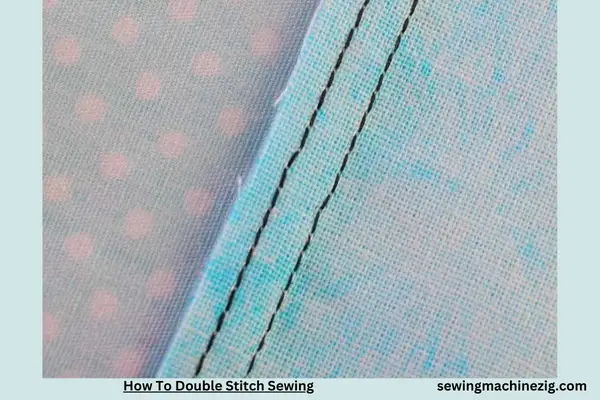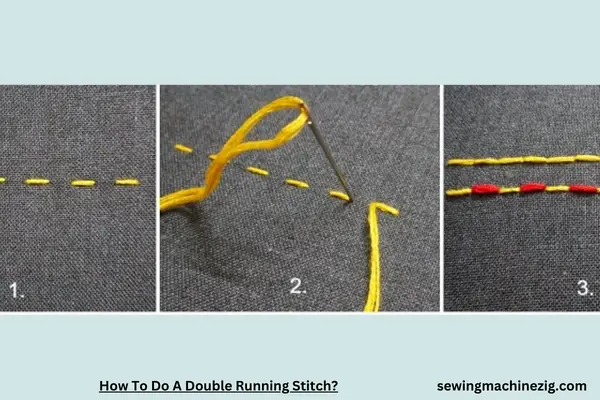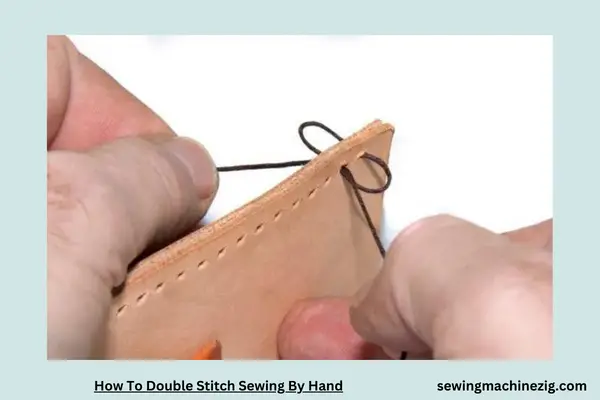
Mastering the art of double stitching in sewing opens up avenues for reinforced seams and enhanced durability in your projects. But How To Double Stitch Sewing? Double stitching involves sewing a parallel line of stitches next to the original seam, adding strength and stability.
This technique is particularly useful for securing edges, reinforcing stress points, or creating decorative effects. Whether you’re a beginner or a seasoned sewist, understanding how to double stitch provides a versatile skill that elevates the longevity and visual appeal of your garments and crafts.
How To Double Stitch Sewing Detailed Answer

Mastering the technique of double stitching in sewing is a valuable skill that enhances the strength and durability of your stitches. Whether you’re reinforcing seams or adding decorative elements to your projects, understanding how to double stitch provides versatility in your sewing repertoire.
In this detailed guide,” How To Double Stitch Sewing’, We’ll explore the step-by-step process of double stitching, offering insights into its applications and benefits.
Step 1: Set Up Your Sewing Machine:
Begin by selecting a sewing machine with a straight stitch function. Ensure you have the appropriate needle and thread for your fabric. Double stitching is particularly effective for heavyweight fabrics or areas of a garment that experience increased stress.
Step 2: Thread the Machine:
Thread your sewing machine, making sure to use a thread color that complements your fabric. If you’re aiming for a decorative double stitch, consider using a contrasting thread for added visual interest.
Step 3: Prepare the Fabric:
Place the fabric under the presser foot, aligning the edges you intend to double-stitch. If you’re reinforcing a seam, ensure that the edges are accurately aligned and pinned securely.
Step 4: Set the Stitch Length:
Adjust the stitch length on your sewing machine. Double stitching typically involves using a slightly longer stitch length than usual. Experiment on a scrap piece of fabric to determine the desired stitch length for your specific project.
Step 5: Stitch the First Line:
Begin by sewing the first line of stitches along the designated seam or area. Sew slowly and consistently, maintaining an even seam allowance. Backstitch at the beginning and end to secure the stitches.
Step 6: Return and Sew the Second Line:
Once the first line of stitches is complete, return to the starting point and sew a second line of stitches parallel to the first. Keep the stitching lines evenly spaced to achieve a neat and professional look.
Step 7: Backstitch at the End:
Upon completing the second line of stitches, backstitch again to secure the threads. This additional reinforcement at the beginning and end of the double stitch adds strength to the overall seam.
Step 8: Press the Seams:
Press the seams with an iron to set the stitches and create a polished finish. This step is crucial for achieving a professional look and ensuring that the double stitches lay flat.
Step 9: Evaluate and Adjust:
Examine the double-stitched area to ensure that the lines are parallel, the stitches are even, and the fabric is secure. If necessary, make adjustments to the stitch length or tension to achieve the desired result.
Step 10: Creative Applications:
Beyond reinforcing seams, double stitching can be used decoratively. Experiment with different stitch lengths, thread colors, and patterns to add unique and eye-catching details to your sewing projects.
Learning how to double stitch in sewing provides a valuable technique for both functional and decorative purposes. By following this comprehensive step-by-step guide, you can confidently incorporate double stitching into your projects, adding strength, durability, and creative flair to your sewing endeavors.
Whether you’re a beginner or an experienced sewist, mastering the art of double stitching expands your repertoire and elevates the quality of your handmade creations
How To Do A Double Running Stitch?

A double running stitch, also referred to as a Holbein stitch or a line stitch, is a hand embroidery technique recognized by a series of parallel stitches worked in two passes. It produces a solid, reversible line with a distinctive appearance. If you’re wondering how to double-stitch sewing, this step-by-step guide will walk you through the process.
Materials Needed:
- Fabric
- Embroidery floss or thread
- Embroidery needle
Step-by-Step Guide:
Thread the Needle:
- Select your embroidery thread or floss and thread it through the needle.
- Tie a knot at the end of the thread.
Start with a Single Running Stitch:
- Bring the needle up through the back of the fabric, creating a small stitch.
- Continue making consecutive stitches in a straight line. These are your first pass of running stitches.
Return in the Opposite Direction:
- When you reach the end of your line of running stitches, turn your needle around.
- Instead of making new stitches, bring the needle back through the existing stitches in the opposite direction.
Complete the Second Pass:
- As you return through the existing stitches, create a second set of stitches that mirror the first set.
- The needle should go through the center of each previous stitch, essentially doubling the thickness of the line. This is a crucial step in learning how to double-stitch sewing.
Continue the Pattern:
- Repeat the process, working back and forth in a zigzag manner.
- Ensure that each stitch in the second pass aligns with a stitch from the first pass.
Finish the Line:
- When you reach the end of your line or design, secure the thread by making a small knot on the back of the fabric.
Tips:
- The key to a double-running stitch is that the backside of the embroidery looks the same as the front, making it reversible.
- Maintain even spacing and tension between stitches for a neat appearance.
- Experiment with different thread colors to create interesting patterns and designs.
Important Note:
The double running stitch, or How To Double Stitch Sewing, is often employed in blackwork embroidery and other historical embroidery styles. It creates a visually striking effect and is great for outlining or creating intricate patterns.
By following these simple steps on How To Double Stitch Sewing, you can easily master the double running stitch and use it to enhance your embroidery projects with a classic and timeless look
How To Double Stitch Sewing By Hand

Double stitching in hand sewing involves reinforcing stitches to add durability and strength to your fabric. Here’s a simple guide on how to double stitch sewing by hand:
Materials Needed:
- Needle
- Thread
- Fabric
Step-by-Step Guide:
Thread the Needle:
- Select a needle and thread that match your fabric.
- Thread the needle and tie a knot at the end.
Start with a Single Stitch:
- Begin by bringing the needle up through the fabric from the back to the front.
- Pull the thread until the knot is snug against the fabric.
Create the First Stitch:
- Insert the needle back into the fabric, a short distance away from the starting point.
- Pull the needle through to form a single stitch.
Repeat for the Second Stitch:
- Bring the needle up through the fabric again, creating a second stitch.
- Keep the stitches evenly spaced for a neat look.
Double Stitching:
- To double-stitch, insert the needle back into the same hole as the previous stitch.
- This reinforces the initial stitch, adding strength.
Continue Double Stitching:
- Repeat the process of stitching and doubling up, creating a continuous line of reinforced stitches.
Secure the End:
- When you reach the end of your sewing, make a small knot on the backside of the fabric to secure the thread.
Tips:
- Use a thimble to protect your fingers when pushing the needle through the fabric.
- Experiment with different thread colors to match or contrast with your fabric.
- Practice on a scrap piece of fabric to perfect your double stitching technique.
Benefits of Double Stitching:
- Enhanced durability: Double stitching adds strength to your seams, reducing the risk of unraveling.
- Improved stability: Ideal for areas that experience stress, like buttonholes or hems.
- Neat appearance: The doubled stitches provide a clean and polished finish to your hand-sewn projects.
By following these easy steps, you can double stitch sewing by hand, reinforcing your stitches for added durability and creating sturdy, long-lasting projects.”
CONCLUSION
To conclude, mastering How To Double Stitch Sewing enhances the durability and strength of your hand-sewn projects. This technique, involving reinforced stitches, provides a sturdy finish ideal for areas experiencing stress, such as hems or buttonholes.
The benefits include improved stability, neat appearances, and heightened resistance against unraveling. As you incorporate the art of double stitching into your sewing repertoire, you ensure that your creations withstand the test of time, offering both functionality and longevity. How To Double Stitch Sewing is a valuable skill for any sewing enthusiast.
FAQS
Q: What is double stitching in sewing, and how is it different from a regular stitch?
A: Double stitching in sewing involves creating two parallel rows of stitches, reinforcing the seam for added durability. It differs from a regular stitch, which consists of a single row. Double stitching is commonly used in areas of a garment that undergo increased stress or tension, providing extra strength and stability.
Q: When should I use double stitching in my sewing projects?
A: Use double stitching in areas that experience heightened stress, such as seams, hems, or closures like buttonholes. It’s especially beneficial for securing items that endure frequent use or tension, enhancing the overall strength and longevity of the sewn project.
Q: Can I double stitch by hand, or is it primarily done using a sewing machine?
A: Double stitching can be done both by hand and with a sewing machine. When hand-sewing, simply create two parallel rows of stitches, ensuring they are evenly spaced. When using a sewing machine, select the appropriate stitch setting or manually sew two rows close together, reinforcing the targeted area.
Q: Does double stitching affect the appearance of the finished garment?
A: Double stitching may create a subtle textured appearance due to the parallel rows of stitches. This effect is often more noticeable in topstitching or visible seams. However, if done with precision, double stitching should enhance the overall neatness and durability of the garment without significantly altering its aesthetic.
Q: Are there specific fabrics or projects where double stitching is more beneficial?
A: Double stitching is particularly beneficial for heavy fabrics, denim, or projects that involve items subjected to frequent stress, like bags or outerwear. However, it can be applied to a variety of fabrics and projects where reinforced seams are desired for increased strength.
Q: Can double stitching replace other reinforcement techniques, such as interfacing or seam binding?
A: While double stitching provides robust reinforcement, it is not a direct replacement for techniques like interfacing or seam binding. These methods serve different purposes. Double stitching is effective for enhancing seam strength while interfacing and seam binding are used for stabilizing fabric edges or adding structure to certain areas of a garment.



